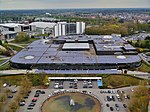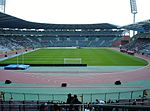Brussels Expo
1935 establishments in BelgiumBuildings and structures in BrusselsCity of BrusselsEvent venues established in 1935Use British English from December 2021 ... and 2 more
World's fair sites in BelgiumWorld's fairs in Brussels

The Brussels Exhibition Centre (French: Parc des Expositions de Bruxelles, Dutch: Tentoonstellingspark van Brussel), also known as Brussels Expo, is the most important event complex in Brussels, Belgium. Located on the Heysel/Heizel Plateau in Laeken (northern part of the City of Brussels), the twelve halls that comprise it are used for the largest national and international trade fairs, exhibitions and other events. With 115,000 m2 (1,240,000 sq ft) of facility space, they constitute the largest exhibition space in the Benelux. They are also a remarkable witness to the evolution of construction techniques during the 20th century.
Excerpt from the Wikipedia article Brussels Expo (License: CC BY-SA 3.0, Authors, Images).Brussels Expo
Place de Belgique - Belgieplein, City of Brussels
Geographical coordinates (GPS) Address Phone number Website External links Nearby Places Show on map
Geographical coordinates (GPS)
| Latitude | Longitude |
|---|---|
| N 50.899722222222 ° | E 4.3380555555556 ° |
Address
Brussels Expo
Place de Belgique - Belgieplein 1
1020 City of Brussels
Belgium
Open on Google Maps









